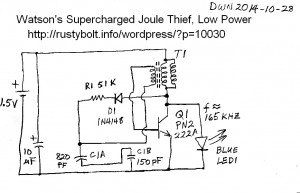One might think that there is not much point in trying to get more light out of a single battery when the light output is very low and the cell is going to run for weeks. But the Supercharged Joule Thief has proved to be much more efficient and is capable of doubling the the light output for the same battery current, or doubling the run time with the same light output (see note at end).

I modified a Supercharged Joule Thief PC board I designed few years ago to reduce the current from the battery and to the LED, in order to maximize the battery life. My original circuit (see note at end) used a 1.5k resistor and a capacitor of between 560 and 1000 pF. The coil was a 1/4 inch (6mm) O.D. high permeability toroid core with windings of about 7 inches (177mm) of 30 AWG (.25mm) enameled magnet wire. The transistor was a BC337-25. The LED was a blue 5mm. A typical choice for a battery is a 1.5 volt AA cell.
I used all of these same components except I changed the resistor to 51k and the capacitor to 127 pF. I actually used a 100k pot and a 500 pF variable capacitor to adjust the values. The pot was set to about 50k and the LED current was about 5 mA. I adjusted the variable capacitor to about 125 pF and the current came to a very broad peak. At this low current the LED is not very bright so I measured the voltage across the 1 ohm resistor in series with the LED. The frequency was about 165 kHz.
Note: The original Supercharged Joule Thief schematic.
The Combined schematic of conventional and Supercharged Joule Thief with a switch to choose between the two.












what would the lumens be at regular working conditions. So when the JT is applied how much more brightness would the Led cast out?
The schematic in the link at the end has the chart with the outputs for both switch settings, but in the low power schematic, the lumens or mCd (millicandelas) are very low – I haven’t measured it. The low power SJT makes a good night light, and can run for a week or more on a ‘dead’ AA cell.
In the link at the end it shows that the JT has about half the brightness of the SJT for the same current. Or the JT loses about half the power, the SJT loses much less, about 1/4.
I made the SJT and the low power, the one from the page. I can’t decide which is brighter. I could say I’m doing a blind test because I don’t have multimeter. Also, i tried removing the electrolytic capacitor and the resistors next to the diode and it sitll works. Does the value of the capacitor improve performance ( i don’t care about lifetime)
The value of C1 makes a difference, but it can have any value fro 1/2 to 2 times the value. The peak is very broad, you might think of it as a hill, not a mountain peak.
The circuit may still work with changes or removals, but I chose the optimum values for better performance, and any changes may affect the performance.
I’m going to write a blog about your comment. It will start with 2015-10-29 so you can search for it.